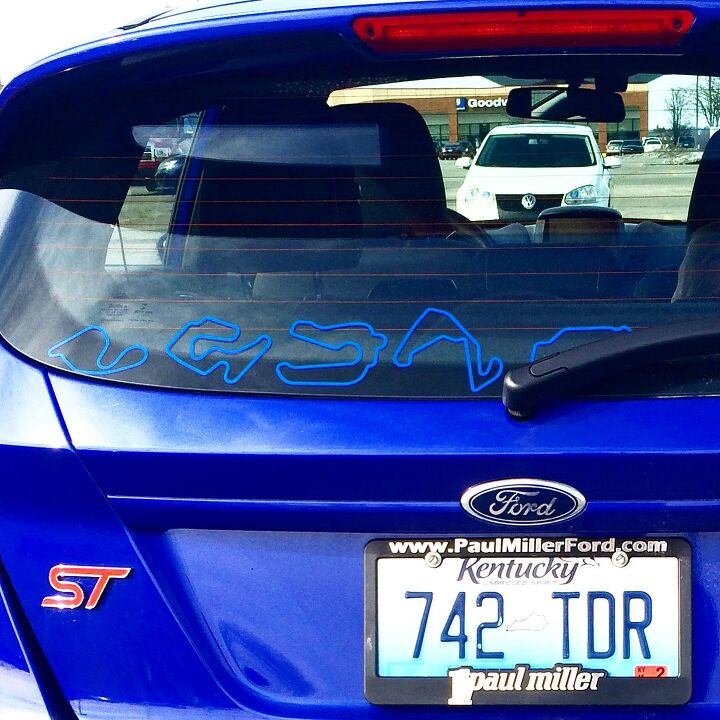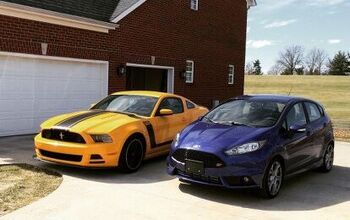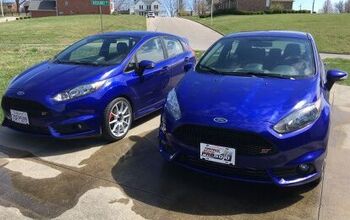Long-term Tester Update: Fiesta ST on the Free-Love Freeway

“Whoa, hold on. A car hauler is actively trying to run me off the road.”
Yesterday, I was talking to my older brother via Bluetooth while driving home from Louisville when, for the third time in approximately ninety miles of highway driving, a trucker was moving over on me in a way that clearly indicated that he hadn’t seen me. Not in the passive aggressive way that truckers normally do, when they put on a blinker and start moving slowly in expectation that you’ll just get out of their way—no, this was a straight-up swing out into what he perceived to be an empty lane. I quickly checked my mirrors and accelerated into the adjacent lane.
“You in the FiST?” my brother asked.
“But of course!” I replied.
Such is the danger of driving a B segment car on the highways of the Commonwealth of Kentucky.
In the weeks since I last updated you on my leasership of my 2015 Fiesta ST, I’ve had the opportunity to put some serious highway miles on it. After its first month of living with me, when I racked up a whopping 500 miles or so as the snow and ice pummeled the Midwest, I’ve since put an additional 1800 miles on the clock for a total of 2300. For those of you keeping track at home, that’s 2300 miles that didn’t go on my Boss 302 (come on, equity building!), but equally important is that I did 2300 miles at a combined 30 MPG as opposed to a combined 18 MPG.
Although the Fiesta ST doesn’t necessarily require premium fuel, it’s much happier drinking 93 octane than 87—I’ve noticed about 33 MPG highway on 87 versus 35 MPG on 93. There is also a noticeable torque difference. In theory, the ECU can tell the difference when you use regular versus premium and adjusts the ignition timing accordingly. In practice, the car feels better on 93. For highway cruising, though, it doesn’t matter much.
As good as the Fiesta is on back roads, for long stretches of highway miles, it can leave a little to be desired. The stiffly sprung suspension does not care for potholes at all, and the long, cold winter of Kentucky, Ohio, and Indiana seems to have created more than I can remember in years past. There’s no such thing as mindless driving behind the wheel of the ST—one divot in the middle of a lane can ruin your day, or in my case, your alignment. A particularly nasty bump on I-64 in Kentucky seems to have knocked my alignment off ever so slightly, to the point where the steering wheel is listing a bit to the right. I’ll have to get that looked at this week.
As I mentioned at the beginning, the Fiesta ST is invisible to truckers. Not only that, it also appears to be invisible to Tahoes and F-250s. I am typically forced into evasive action about once a day if there’s even a bit of traffic around me.
Visibility out of the rear windshield is a bit limited (especially with track decals), and the truck-style side mirrors take a bit of getting used to.
There are pluses, however. It’s surprisingly quiet on the freeway. Tire and wind noise are minimal, even at speeds approaching triple digits. The Bluetooth works flawlessly, and it’s even suitable for taking a conference call—nobody will know that you’re in the car. I don’t have the Recaro seat option in my car, and I’m actually pretty glad about that when it comes to highway driving. Although I fit in them just fine, one doesn’t always want to be gripped like a glove when driving 250 miles at a time. The standard seats have lumbar support, but I like it best without it.
I’ve had exactly zero issues with MyFordTouch so far. The navigation system is excellent for daily usage—easily the best I’ve used in a car. Mrs. Bark used it to navigate her way out of a closed highway situation last weekend, saving her over an hour. While I have no plans to extend my Sirius trial, I have to admit that it’s useful for traveling longer distances, or for driving through areas where my phone can’t easily stream Spotify.
Okay, so this bit doesn’t have anything to do with freeway driving, but I wanted to include it anyway. There’s this little button on the center console. I pressed it a few times during the day, but nothing seemed to happen.
But at night, it’s a different story. Observe:
I know, it’s a little dorky, but I dig it.
In the next month, I’ll be taking the ST to its first autocross (where I expect to be stoned by angry jorts-wearers) as well as its first track day. I look forward to sharing those experiences with you, as well.
Questions? Comments? Concerns? Rude Remarks? GO!

More by Mark "Bark M." Baruth
Latest Car Reviews
Read moreLatest Product Reviews
Read moreRecent Comments
- ToolGuy If these guys opened a hotel outside Cincinnati I would go there to sleep, and to dream.
- ToolGuy Michelin's price increases mean that my relationship with them as a customer is not sustainable. 🙁
- Kwik_Shift_Pro4X I wonder if Fiat would pull off old world Italian charm full of well intentioned stereotypes.
- Chelsea I actually used to work for this guy
- SaulTigh Saw my first Cybertruck last weekend. Looked like a kit car...not an even panel to be seen.




































Comments
Join the conversation
interesting that the premium petrol was noticeable. when prices plummeted in february, i fed my focus st a tank of premium. noticed nowt: zero difference. perhaps that's a california thing?
The signal on, move over slowly thing - isn't passive-aggressive. It's the only way for a truck to change lanes in traffic. If they don't do that, they will be stuck in the same lane indefinitely. Most drivers leave less following distance than the length of the trailer. They can't accelerate from 55 to 60 mph very quickly. But they still want to get past the guy going 55, because doing 60 will get them 5 miles further in an hour. For guys who get paid by the mile, that's a very valuable 50-60 miles further in a day. I don't drive a semi truck, but I do drive a 32' 5-ton for my work. I strongly recommend not hanging out in my blind spot.